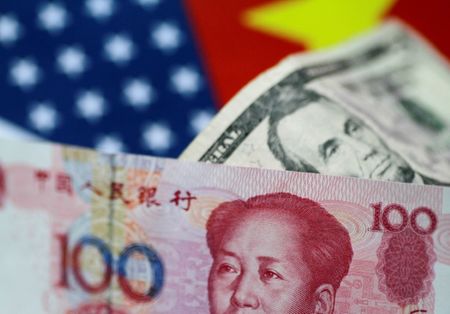

Investing.com– The Chinese language yuan hit a four-month low in opposition to a rallying greenback on Monday as Asian currencies fell sharply on U.S. President-elect Donald Trump’s newest menace to impose hefty tariffs on BRICS nations.
Trump threatened to impose 100% tariffs on BRICS international locations – together with Brazil, Russia, India, China, and South Africa – in a social media put up on Sunday. He vowed of extreme financial penalties for any nation making an attempt to undermine the U.S. greenback’s dominance by backing various currencies. His warning, geared toward international locations in search of to cut back their reliance on the greenback in international commerce, despatched ripples by Asian markets, with issues mounting over potential disruptions in commerce relations.
The menace follows Trump’s earlier vow to impose greater tariffs on items from China, Mexico, and Canada, sparking fears of a renewed commerce battle between the world’s largest economies. Heightened tensions weighed closely on sentiment in the direction of risk-driven markets in Asia, denting regional currencies.
The surged 0.5%, whereas the jumped 0.4%, benefiting from the dollar’s standing as a worldwide safe-haven asset.
The South Korean received, and the Japanese yen led losses amongst Asian currencies, with the pair rising 0.6% and South Korea’s climbing 0.7%.
The Singapore greenback’s pair, and the Thai baht’s pair fell 0.5% every.
The Indian rupee’s pair rose 0.2% to a report excessive of 84.708 rupees.
The rupee was additionally pressured by information on Friday that confirmed that India’s development slowed within the July-September interval in comparison with the earlier quarter. Nonetheless, India maintained its standing because the world’s fastest-growing main economic system, outpacing China’s 4.6% development throughout the identical interval.
China’s yuan below stress regardless of robust financial information
The Chinese language yuan’s onshore pair rose 0.3% and was at its highest stage since late-July, taking little assist from optimistic buying managers index information for November.
China’s official for November confirmed a modest development, signaling a restoration in manufacturing unit output, whereas the private-sector additionally rose to its highest stage since June. The information was seen as a optimistic signal for the Chinese language economic system after a barrage of aggressive stimulus measures prior to now two months.
Nonetheless, issues persist over the affect of rising commerce tensions on Chinese language exports, which stay sluggish. The yuan weakened 1.8% in opposition to the greenback in November, pushed by fears of an intensifying U.S.-China commerce dispute, particularly after Trump’s election victory.
Greenback on the rise as buyers search for fee cues; regional information awaited
The greenback began the primary day of the week, and the month on an upbeat observe, as markets now anticipate a slower fee reduce path by the Federal Reserve, though 1 / 4 share reduce is broadly anticipated on the Fed’s December assembly. Buyers are nonetheless on the lookout for extra cues on the central financial institution’s fee outlook.
Fed is about to talk on Wednesday, whereas key U.S. information for November can also be due later within the week.
In Asia Pacific area, the Reserve Financial institution of India will determine on its on Friday, and is broadly anticipated to maintain charges unchanged amid sticky Indian inflation.
Australia is about to launch its third-quarter figures on Wednesday.